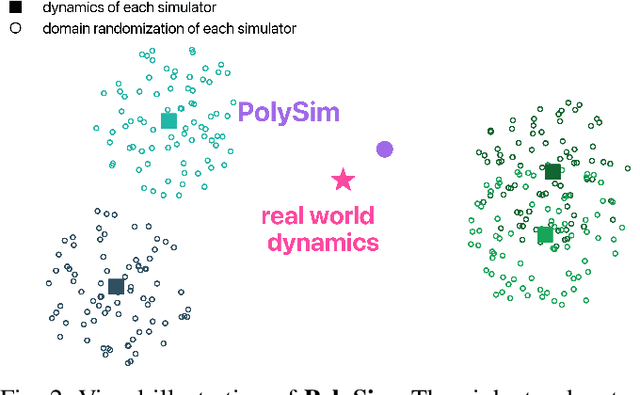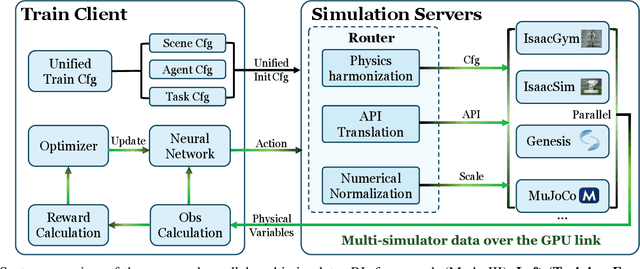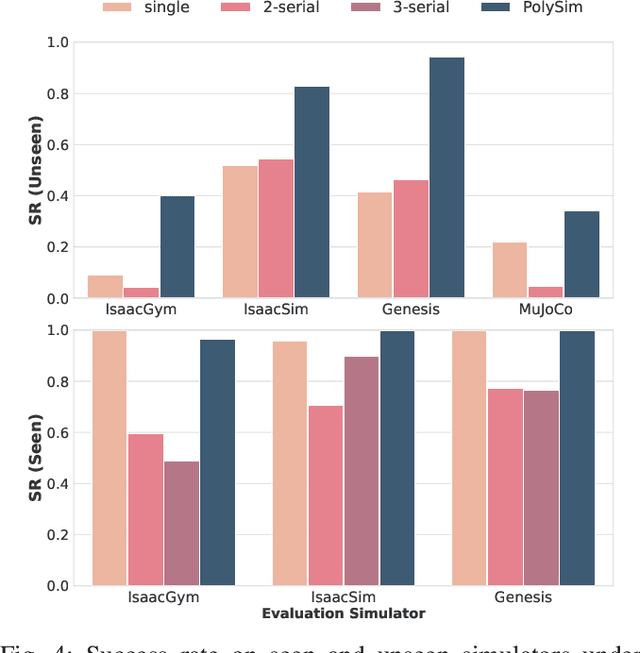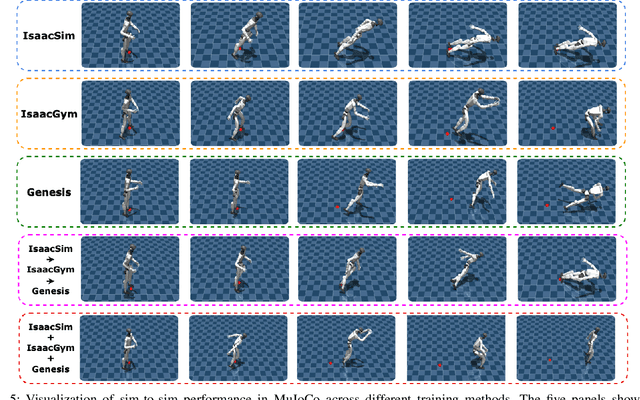Siheng Chen
PolySim: Bridging the Sim-to-Real Gap for Humanoid Control via Multi-Simulator Dynamics Randomization
Oct 02, 2025



Abstract:Humanoid whole-body control (WBC) policies trained in simulation often suffer from the sim-to-real gap, which fundamentally arises from simulator inductive bias, the inherent assumptions and limitations of any single simulator. These biases lead to nontrivial discrepancies both across simulators and between simulation and the real world. To mitigate the effect of simulator inductive bias, the key idea is to train policies jointly across multiple simulators, encouraging the learned controller to capture dynamics that generalize beyond any single simulator's assumptions. We thus introduce PolySim, a WBC training platform that integrates multiple heterogeneous simulators. PolySim can launch parallel environments from different engines simultaneously within a single training run, thereby realizing dynamics-level domain randomization. Theoretically, we show that PolySim yields a tighter upper bound on simulator inductive bias than single-simulator training. In experiments, PolySim substantially reduces motion-tracking error in sim-to-sim evaluations; for example, on MuJoCo, it improves execution success by 52.8 over an IsaacSim baseline. PolySim further enables zero-shot deployment on a real Unitree G1 without additional fine-tuning, showing effective transfer from simulation to the real world. We will release the PolySim code upon acceptance of this work.
InfoMosaic-Bench: Evaluating Multi-Source Information Seeking in Tool-Augmented Agents
Oct 02, 2025Abstract:Information seeking is a fundamental requirement for humans. However, existing LLM agents rely heavily on open-web search, which exposes two fundamental weaknesses: online content is noisy and unreliable, and many real-world tasks require precise, domain-specific knowledge unavailable from the web. The emergence of the Model Context Protocol (MCP) now allows agents to interface with thousands of specialized tools, seemingly resolving this limitation. Yet it remains unclear whether agents can effectively leverage such tools -- and more importantly, whether they can integrate them with general-purpose search to solve complex tasks. Therefore, we introduce InfoMosaic-Bench, the first benchmark dedicated to multi-source information seeking in tool-augmented agents. Covering six representative domains (medicine, finance, maps, video, web, and multi-domain integration), InfoMosaic-Bench requires agents to combine general-purpose search with domain-specific tools. Tasks are synthesized with InfoMosaic-Flow, a scalable pipeline that grounds task conditions in verified tool outputs, enforces cross-source dependencies, and filters out shortcut cases solvable by trivial lookup. This design guarantees both reliability and non-triviality. Experiments with 14 state-of-the-art LLM agents reveal three findings: (i) web information alone is insufficient, with GPT-5 achieving only 38.2% accuracy and 67.5% pass rate; (ii) domain tools provide selective but inconsistent benefits, improving some domains while degrading others; and (iii) 22.4% of failures arise from incorrect tool usage or selection, highlighting that current LLMs still struggle with even basic tool handling.
Rate-Distortion Optimized Communication for Collaborative Perception
Sep 26, 2025



Abstract:Collaborative perception emphasizes enhancing environmental understanding by enabling multiple agents to share visual information with limited bandwidth resources. While prior work has explored the empirical trade-off between task performance and communication volume, a significant gap remains in the theoretical foundation. To fill this gap, we draw on information theory and introduce a pragmatic rate-distortion theory for multi-agent collaboration, specifically formulated to analyze performance-communication trade-off in goal-oriented multi-agent systems. This theory concretizes two key conditions for designing optimal communication strategies: supplying pragmatically relevant information and transmitting redundancy-less messages. Guided by these two conditions, we propose RDcomm, a communication-efficient collaborative perception framework that introduces two key innovations: i) task entropy discrete coding, which assigns features with task-relevant codeword-lengths to maximize the efficiency in supplying pragmatic information; ii) mutual-information-driven message selection, which utilizes mutual information neural estimation to approach the optimal redundancy-less condition. Experiments on 3D object detection and BEV segmentation demonstrate that RDcomm achieves state-of-the-art accuracy on DAIR-V2X and OPV2V, while reducing communication volume by up to 108 times. The code will be released.
BrowseMaster: Towards Scalable Web Browsing via Tool-Augmented Programmatic Agent Pair
Aug 12, 2025Abstract:Effective information seeking in the vast and ever-growing digital landscape requires balancing expansive search with strategic reasoning. Current large language model (LLM)-based agents struggle to achieve this balance due to limitations in search breadth and reasoning depth, where slow, serial querying restricts coverage of relevant sources and noisy raw inputs disrupt the continuity of multi-step reasoning. To address these challenges, we propose BrowseMaster, a scalable framework built around a programmatically augmented planner-executor agent pair. The planner formulates and adapts search strategies based on task constraints, while the executor conducts efficient, targeted retrieval to supply the planner with concise, relevant evidence. This division of labor preserves coherent, long-horizon reasoning while sustaining broad and systematic exploration, overcoming the trade-off that limits existing agents. Extensive experiments on challenging English and Chinese benchmarks show that BrowseMaster consistently outperforms open-source and proprietary baselines, achieving scores of 30.0 on BrowseComp-en and 46.5 on BrowseComp-zh, which demonstrates its strong capability in complex, reasoning-heavy information-seeking tasks at scale.
Communication-Efficient Multi-Agent 3D Detection via Hybrid Collaboration
Aug 09, 2025Abstract:Collaborative 3D detection can substantially boost detection performance by allowing agents to exchange complementary information. It inherently results in a fundamental trade-off between detection performance and communication bandwidth. To tackle this bottleneck issue, we propose a novel hybrid collaboration that adaptively integrates two types of communication messages: perceptual outputs, which are compact, and raw observations, which offer richer information. This approach focuses on two key aspects: i) integrating complementary information from two message types and ii) prioritizing the most critical data within each type. By adaptively selecting the most critical set of messages, it ensures optimal perceptual information and adaptability, effectively meeting the demands of diverse communication scenarios.Building on this hybrid collaboration, we present \texttt{HyComm}, a communication-efficient LiDAR-based collaborative 3D detection system. \texttt{HyComm} boasts two main benefits: i) it facilitates adaptable compression rates for messages, addressing various communication requirements, and ii) it uses standardized data formats for messages. This ensures they are independent of specific detection models, fostering adaptability across different agent configurations. To evaluate HyComm, we conduct experiments on both real-world and simulation datasets: DAIR-V2X and OPV2V. HyComm consistently outperforms previous methods and achieves a superior performance-bandwidth trade-off regardless of whether agents use the same or varied detection models. It achieves a lower communication volume of more than 2,006$\times$ and still outperforms Where2comm on DAIR-V2X in terms of AP50. The related code will be released.
ML-Agent: Reinforcing LLM Agents for Autonomous Machine Learning Engineering
May 29, 2025Abstract:The emergence of large language model (LLM)-based agents has significantly advanced the development of autonomous machine learning (ML) engineering. However, most existing approaches rely heavily on manual prompt engineering, failing to adapt and optimize based on diverse experimental experiences. Focusing on this, for the first time, we explore the paradigm of learning-based agentic ML, where an LLM agent learns through interactive experimentation on ML tasks using online reinforcement learning (RL). To realize this, we propose a novel agentic ML training framework with three key components: (1) exploration-enriched fine-tuning, which enables LLM agents to generate diverse actions for enhanced RL exploration; (2) step-wise RL, which enables training on a single action step, accelerating experience collection and improving training efficiency; (3) an agentic ML-specific reward module, which unifies varied ML feedback signals into consistent rewards for RL optimization. Leveraging this framework, we train ML-Agent, driven by a 7B-sized Qwen-2.5 LLM for autonomous ML. Remarkably, despite being trained on merely 9 ML tasks, our 7B-sized ML-Agent outperforms the 671B-sized DeepSeek-R1 agent. Furthermore, it achieves continuous performance improvements and demonstrates exceptional cross-task generalization capabilities.
X-MAS: Towards Building Multi-Agent Systems with Heterogeneous LLMs
May 22, 2025



Abstract:LLM-based multi-agent systems (MAS) extend the capabilities of single LLMs by enabling cooperation among multiple specialized agents. However, most existing MAS frameworks rely on a single LLM to drive all agents, constraining the system's intelligence to the limit of that model. This paper explores the paradigm of heterogeneous LLM-driven MAS (X-MAS), where agents are powered by diverse LLMs, elevating the system's potential to the collective intelligence of diverse LLMs. We introduce X-MAS-Bench, a comprehensive testbed designed to evaluate the performance of various LLMs across different domains and MAS-related functions. As an extensive empirical study, we assess 27 LLMs across 5 domains (encompassing 21 test sets) and 5 functions, conducting over 1.7 million evaluations to identify optimal model selections for each domain-function combination. Building on these findings, we demonstrate that transitioning from homogeneous to heterogeneous LLM-driven MAS can significantly enhance system performance without requiring structural redesign. Specifically, in a chatbot-only MAS scenario, the heterogeneous configuration yields up to 8.4\% performance improvement on the MATH dataset. In a mixed chatbot-reasoner scenario, the heterogeneous MAS could achieve a remarkable 47\% performance boost on the AIME dataset. Our results underscore the transformative potential of heterogeneous LLMs in MAS, highlighting a promising avenue for advancing scalable, collaborative AI systems.
SWE-Dev: Evaluating and Training Autonomous Feature-Driven Software Development
May 22, 2025Abstract:Large Language Models (LLMs) have shown strong capability in diverse software engineering tasks, e.g. code completion, bug fixing, and document generation. However, feature-driven development (FDD), a highly prevalent real-world task that involves developing new functionalities for large, existing codebases, remains underexplored. We therefore introduce SWE-Dev, the first large-scale dataset (with 14,000 training and 500 test samples) designed to evaluate and train autonomous coding systems on real-world feature development tasks. To ensure verifiable and diverse training, SWE-Dev uniquely provides all instances with a runnable environment and its developer-authored executable unit tests. This collection not only provides high-quality data for Supervised Fine-Tuning (SFT), but also enables Reinforcement Learning (RL) by delivering accurate reward signals from executable unit tests. Our extensive evaluations on SWE-Dev, covering 17 chatbot LLMs, 10 reasoning models, and 10 Multi-Agent Systems (MAS), reveal that FDD is a profoundly challenging frontier for current AI (e.g., Claude-3.7-Sonnet achieves only 22.45\% Pass@3 on the hard test split). Crucially, we demonstrate that SWE-Dev serves as an effective platform for model improvement: fine-tuning on training set enabled a 7B model comparable to GPT-4o on \textit{hard} split, underscoring the value of its high-quality training data. Code is available here \href{https://github.com/justLittleWhite/SWE-Dev}{https://github.com/justLittleWhite/SWE-Dev}.
MASLab: A Unified and Comprehensive Codebase for LLM-based Multi-Agent Systems
May 22, 2025Abstract:LLM-based multi-agent systems (MAS) have demonstrated significant potential in enhancing single LLMs to address complex and diverse tasks in practical applications. Despite considerable advancements, the field lacks a unified codebase that consolidates existing methods, resulting in redundant re-implementation efforts, unfair comparisons, and high entry barriers for researchers. To address these challenges, we introduce MASLab, a unified, comprehensive, and research-friendly codebase for LLM-based MAS. (1) MASLab integrates over 20 established methods across multiple domains, each rigorously validated by comparing step-by-step outputs with its official implementation. (2) MASLab provides a unified environment with various benchmarks for fair comparisons among methods, ensuring consistent inputs and standardized evaluation protocols. (3) MASLab implements methods within a shared streamlined structure, lowering the barriers for understanding and extension. Building on MASLab, we conduct extensive experiments covering 10+ benchmarks and 8 models, offering researchers a clear and comprehensive view of the current landscape of MAS methods. MASLab will continue to evolve, tracking the latest developments in the field, and invite contributions from the broader open-source community.
Incentivizing Inclusive Contributions in Model Sharing Markets
May 05, 2025Abstract:While data plays a crucial role in training contemporary AI models, it is acknowledged that valuable public data will be exhausted in a few years, directing the world's attention towards the massive decentralized private data. However, the privacy-sensitive nature of raw data and lack of incentive mechanism prevent these valuable data from being fully exploited. Addressing these challenges, this paper proposes inclusive and incentivized personalized federated learning (iPFL), which incentivizes data holders with diverse purposes to collaboratively train personalized models without revealing raw data. iPFL constructs a model-sharing market by solving a graph-based training optimization and incorporates an incentive mechanism based on game theory principles. Theoretical analysis shows that iPFL adheres to two key incentive properties: individual rationality and truthfulness. Empirical studies on eleven AI tasks (e.g., large language models' instruction-following tasks) demonstrate that iPFL consistently achieves the highest economic utility, and better or comparable model performance compared to baseline methods. We anticipate that our iPFL can serve as a valuable technique for boosting future AI models on decentralized private data while making everyone satisfied.
 Add to Chrome
Add to Chrome Add to Firefox
Add to Firefox Add to Edge
Add to Edge